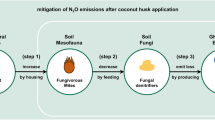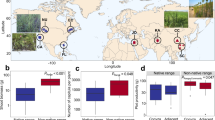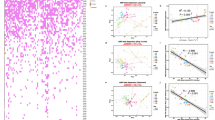Abstract
N2O is a potent greenhouse gas involved in the destruction of the protective ozone layer in the stratosphere and contributing to global warming. The ecological processes regulating its emissions from soil are still poorly understood. Here, we show that the presence of arbuscular mycorrhizal fungi (AMF), a dominant group of soil fungi, which form symbiotic associations with the majority of land plants and which influence a range of important ecosystem functions, can induce a reduction in N2O emissions from soil. To test for a functional relationship between AMF and N2O emissions, we manipulated the abundance of AMF in two independent greenhouse experiments using two different approaches (sterilized and re-inoculated soil and non-mycorrhizal tomato mutants) and two different soils. N2O emissions were increased by 42 and 33% in microcosms with reduced AMF abundance compared to microcosms with a well-established AMF community, suggesting that AMF regulate N2O emissions. This could partly be explained by increased N immobilization into microbial or plant biomass, reduced concentrations of mineral soil N as a substrate for N2O emission and altered water relations. Moreover, the abundance of key genes responsible for N2O production (nirK) was negatively and for N2O consumption (nosZ) positively correlated to AMF abundance, indicating that the regulation of N2O emissions is transmitted by AMF-induced changes in the soil microbial community. Our results suggest that the disruption of the AMF symbiosis through intensification of agricultural practices may further contribute to increased N2O emissions.
Similar content being viewed by others
Log in or create a free account to read this content
Gain free access to this article, as well as selected content from this journal and more on nature.com
or
References
Ames RN, Reid CPP, Ingham ER . (1984). Rhizosphere bacterial population responses to root colonization by a vesicular arbuscular mycorrhizal fungus. New Phytol 96: 555–563.
Amora-Lazcano E, Vazquez MM, Azcon R . (1998). Response of nitrogen-transforming microorganisms to arbuscular mycorrhizal fungi. Biol Fertil Soils 27: 65–70.
Auge RM . (2001). Water relations, drought and vesicular-arbuscular mycorrhizal symbiosis. Mycorrhiza 11: 3–42.
Bago B, Vierheilig H, Piche Y, AzconAguilar C . (1996). Nitrate depletion and pH changes induced by the extraradical mycelium of the arbuscular mycorrhizal fungus Glomus intraradices grown in monoxenic culture. New Phytol 133: 273–280.
Berks BC, Ferguson SJ, Moir JWB, Richardson DJ . (1995). Enzymes and associated electron transport systems that catalyse the respiratory reduction of nitrogen oxides and oxyanions. Biochim Biophys Acta 1232: 97–173.
Cavagnaro TR, Barrios-Masias FH, Jackson LE . (2012). Arbuscular mycorrhizas and their role in plant growth, nitrogen interception and soil gas efflux in an organic production system. Plant Soil 353: 181–194.
Cheneby D, Perrez S, Devroe C, Hallet S, Couton Y, Bizouard F et al. (2004). Denitrifying bacteria in bulk and maize-rhizospheric soil: diversity and N2O-reducing abilities. Can J Microbiol 50: 469–474.
Cheng L, Booker FL, Tu C, Burkey KO, Zhou L, Shew HD et al. (2012). Arbuscular mycorrhizal fungi increase organic carbon decomposition under elevated CO2 . Science 337: 1084–1087.
Daniell TJ, Davidson J, Alexander CJ, Caul S, Roberts DM . (2012). Improved real-time PCR estimation of gene copy number in soil extracts using an artificial reference. J Microbiol Methods 91: 38–44.
David-Schwartz R, Badani H, Smadar W, Levy AA, Galili G, Kapulnik Y . (2001). Identification of a novel genetically controlled step in mycorrhizal colonization: plant resistance to infection by fungal spores but not extra-radical hyphae. Plant J 27: 561–569.
Deng H, Zhang B, Yin R, Wang H-l, Mitchell SM, Griffiths BS et al. (2010). Long-term effect of re-vegetation on the microbial community of a severely eroded soil in sub-tropical China. Plant Soil 328: 447–458.
Djigal D, Baudoin E, Philippot L, Brauman A, Villenave C . (2010). Shifts in size, genetic structure and activity of the soil denitrifier community by nematode grazing. Eur J Soil Biol 46: 112–118.
Drigo B, Pijl AS, Duyts H, Kielak A, Gamper HA, Houtekamer MJ et al. (2010). Shifting carbon flow from roots into associated microbial communities in response to elevated atmospheric CO2 . Proc Natl Acad Sci USA 107: 10938–10942.
Egerton-Warburton LM, Allen EB . (2000). Shifts in arbuscular mycorrhizal communities along an anthropogenic nitrogen deposition gradient. Ecol Appl 10: 484–496.
Forster P, Ramaswamy V, Artaxo P, Berntsen T, Betts R, Fahey DW et al. (2007). Changes in atmospheric constituents and in radiative forcing. In: Solomon S, Qin D, Manning M, Chen Z, Marquis M, Averyt KB, et al (eds). Climate Change 2007: The Physical Science Basis. Contribution of Working Group I to the Fourth Assessment Report of the Intergovernmental Panel on Climate Change. Cambridge University Press: Cambridge, UK and New York, NY, USA.
Govindarajulu M, Pfeffer PE, Jin HR, Abubaker J, Douds DD, Allen JW et al. (2005). Nitrogen transfer in the arbuscular mycorrhizal symbiosis. Nature 435: 819–823.
Graham JH, Leonard RT, Menge JA . (1981). Membrane-mediated decrease in root exudation responsible for phosphorous inhibition of vesicular-arbuscular mycorrhiza formation. Plant Physiol 68: 548–552.
Grimoldi AA, Kavanova M, Lattanzi FA, Schaufele R, Schnyder H . (2006). Arbuscular mycorrhizal colonization on carbon economy in perennial ryegrass: quantification by 13CO2/12CO2 steady-state labelling and gas exchange. New Phytol 172: 544–553.
Helgason T, Daniell TJ, Husband R, Fitter AH, Young JPW . (1998). Ploughing up the wood-wide web? Nature 394: 431–431.
Herold MB, Baggs EM, Daniell TJ . (2012). Fungal and bacterial denitrification are differently affected by long-term pH amendment and cultivation of arable soil. Soil Biol Biochem 54: 25–35.
Hodge A, Fitter AH . (2010). Substantial nitrogen acquisition by arbuscular mycorrhizal fungi from organic material has implications for N cycling. Proc Natl Acad Sci USA 107: 13754–13759.
Hoeksema JD, Chaudhary VB, Gehring CA, Johnson NC, Karst J, Koide RT et al. (2010). A meta-analysis of context-dependency in plant response to inoculation with mycorrhizal fungi. Ecol Lett 13: 394–407.
Hooker JE, Piatti P, Cheshire MV, Watson CA . (2007). Polysaccharides and monosaccharides in the hyphosphere of the arbuscular mycorrhizal fungi Glomus E3 and Glomus tenue. Soil Biol Biochem 39: 680–683.
Ipsilantis I, Sylvia DM . (2007). Interactions of assemblages of mycorrhizal fungi with two Florida wetland plants. Appl Soil Ecol 35: 261–271.
Johansen A, Jakobsen I, Jensen ES . (1993). Hyphal transport by a vesicular-arbuscular mycorrhizal fungus of N applied to the soil as ammonium or nitrate. Biol Fertil Soils 16: 66–70.
Khalvati MA, Hu Y, Mozafar A, Schmidhalter U . (2005). Quantification of water uptake by arbuscular mycorrhizal hyphae and its significance for leaf growth, water relations, and gas exchange of barley subjected to drought stress. Plant Biol 7: 706–712.
Knowles R . (1982). Denitrification. Microbiol Rev 46: 43–70.
Koide RT, Li MG . (1989). Appropriate controls for vesicular arbuscular mycorrhiza research. New Phytol 111: 35–44.
Kuiper I, De Deyn GB, Thakur MP, Van Groenigen JW . (2013). Soil invertebrate fauna affect N2O emissions from soil. Glob Change Biol 19: 2814–2825.
Laughlin RJ, Stevens RJ . (2002). Evidence for fungal dominance of denitrification and codenitrification in a grassland soil. Soil Sci Soc Am J 66: 1540–1548.
Lubbers IM, van Groenigen KJ, Fonte SJ, Six J, Brussaard L, van Groenigen JW . (2013). Greenhouse-gas emissions from soils increased by earthworms. Nature Clim Change 3: 187–194.
Meissner R, Jacobson Y, Melamed S, Levyatuv S, Shalev G, Ashri A et al. (1997). A new model system for tomato genetics. Plant J 12: 1465–1472.
Mendoza R, Escudero V, Garcia I . (2005). Plant growth, nutrient acquisition and mycorrhizal symbioses of a waterlogging tolerant legume (Lotus glaber Mill.) in a saline-sodic soil. Plant Soil 275: 305–315.
Montzka SA, Dlugokencky EJ, Butler JH . (2011). Non-CO2 greenhouse gases and climate change. Nature 476: 43–50.
Morley N, Baggs EM . (2010). Carbon and oxygen controls on N2O and N2 production during nitrate reduction. Soil Biol Biochem 42: 1864–1871.
Mosier A, Kroeze C, Nevison C, Oenema O, Seitzinger S, van Cleemput O . (1998). Closing the global N2O budget: nitrous oxide emissions through the agricultural nitrogen cycle—OECD/IPCC/IEA phase II development of IPCC guidelines for national greenhouse gas inventory methodology. Nutr Cycl Agroecosyst 52: 225–248.
Nottingham AT, Turner BL, Winter K, van der Heijden MGA, Tanner EVJ . (2010). Arbuscular mycorrhizal mycelial respiration in a moist tropical forest. New Phytol 186: 957–967.
Oehl F, Sieverding E, Mader P, Dubois D, Ineichen K, Boller T et al. (2004). Impact of long-term conventional and organic farming on the diversity of arbuscular mycorrhizal fungi. Oecologia 138: 574–583.
Philippot L, Hallin S, Schloter M . (2007). Ecology of denitrifying prokaryotes in agricultural soil. In: Sparks DL (ed) Advances in Agronomy, Vol 96. Elsevier: New York, pp 249–305.
Philippot L, Andert J, Jones CM, Bru D, Hallin S . (2011). Importance of denitrifiers lacking the genes encoding the nitrous oxide reductase for N2O emissions from soil. Glob Change Biol 17: 1497–1504.
Pinheiro J, Bates D, DebRoy S, Deepayan S . (2011), nlme: Linear and nonlinear mixed effects models. R package Version 3.1-102 edn.
Prendergast-Miller MT, Baggs EM, Johnson D . (2011). Nitrous oxide production by the ectomycorrhizal fungi Paxillus involutus and Tylospora fibrillosa. Fems Microbiol Lett 316: 31–35.
Ravishankara AR, Daniel JS, Portmann RW . (2009). Nitrous oxide (N2O): The dominant ozone-depleting substance emitted in the 21st century. Science 326: 123–125.
Rillig M, Ramsey P, Gannon J, Mummey D, Gadkar V, Kapulnik Y . (2008). Suitability of mycorrhiza-defective mutant/wildtype plant pairs (Solanum lycopersicum L. cv Micro-Tom) to address questions in mycorrhizal soil ecology. Plant Soil 308: 267–275.
Rillig MC, Mummey DL . (2006). Mycorrhizas and soil structure. New Phytol 171: 41–53.
RuizLozano JM, Azcon R . (1995). Hyphal contribution to water uptake in mycorrhizal plants as affected by the fungal species and water status. Physiol Plant 95: 472–478.
Satterthwaite FE . (1946). An approximate distribution of estimates of variance components. Biometrics Bull 2: 110–114.
Scheublin TR, Sanders IR, Keel C, van der Meer JR . (2010). Characterisation of microbial communities colonising the hyphal surfaces of arbuscular mycorrhizal fungi. ISME J 4: 752–763.
Schüssler A, Schwarzott D, Walker C . (2001). A new fungal phylum, the Glomeromycota: phylogeny and evolution. Mycol Res 105: 1413–1421.
Seitzinger S, Harrison JA, Bohlke JK, Bouwman AF, Lowrance R, Peterson B et al. (2006). Denitrification across landscapes and waterscapes: a synthesis. Ecol Appl 16: 2064–2090.
Shoun H, Kim DH, Uchiyama H, Sugiyama J . (1992). Denitrification by fungi. Fems Microbiol Lett 94: 277–281.
Smith KA . (1990). Greenhouse gas fluxes between land surfaces and the atmosphere. Prog Phys Geog 14: 349–372.
Smith SE, Read DJ . (2008) Mycorrhizal Symbiosis 3rd edn. Academic Press: Boston.
Toljander JF, Lindahl BD, Paul LR, Elfstrand M, Finlay RD . (2007). Influence of arbuscular mycorrhizal mycelial exudates on soil bacterial growth and community structure. Fems Microbiol Ecol 61: 295–304.
van der Heijden MGA, Klironomos JN, Ursic M, Moutoglis P, Streitwolf-Engel R, Boller T et al. (1998). Mycorrhizal fungal diversity determines plant biodiversity, ecosystem variability and productivity. Nature 396: 69–72.
van der Heijden MGA, Streitwolf-Engel R, Riedl R, Siegrist S, Neudecker A, Ineichen K et al. (2006). The mycorrhizal contribution to plant productivity, plant nutrition and soil structure in experimental grassland. New Phytol 172: 739–752.
van der Heijden MGA . (2010). Mycorrhizal fungi reduce nutrient loss from model grassland ecosystems. Ecology 91: 1163–1171.
Veresoglou SD, Chen BD, Rillig MC . (2012a). Arbuscular mycorrhiza and soil nitrogen cycling. Soil Biol Biochem 46: 53–62.
Veresoglou SD, Shaw LJ, Hooker JE, Sen R . (2012b). Arbuscular mycorrhizal modulation of diazotrophic and denitrifying microbial communities in the (mycor)rhizosphere of Plantago lanceolata. Soil Biol Biochem 53: 78–81.
Zumft WG . (1997). Cell biology and molecular basis of denitrification. Microbiol Mol Biol Rev 61: 533–616.
Acknowledgements
We would like to thank Yoram Kapulnik for kindly providing seeds of the BC1-mutant/wildtype tomato pair, Caroline Scherrer, Philipp Weber and Christoph Barendregt for helping with the gas measurements, Bernhard Schmid, Franz Conen and Cameron Wagg for helpful discussions in statistics, and Tim George, the editor and two anonymous reviewers for useful comments on the manuscript. This study was funded by the Swiss National Science Foundation (SNSF), grant no. 125428 awarded to MvdH.
Author information
Authors and Affiliations
Corresponding author
Ethics declarations
Competing interests
The authors declare no conflict of interest.
Additional information
Supplementary Information accompanies this paper on The ISME Journal website
Supplementary information
Rights and permissions
About this article
Cite this article
Bender, S., Plantenga, F., Neftel, A. et al. Symbiotic relationships between soil fungi and plants reduce N2O emissions from soil. ISME J 8, 1336–1345 (2014). https://doi.org/10.1038/ismej.2013.224
Received:
Revised:
Accepted:
Published:
Issue date:
DOI: https://doi.org/10.1038/ismej.2013.224
Keywords
This article is cited by
-
Mycorrhiza-mediated recruitment of complete denitrifying Pseudomonas reduces N2O emissions from soil
Microbiome (2023)
-
Soil microbiome indicators can predict crop growth response to large-scale inoculation with arbuscular mycorrhizal fungi
Nature Microbiology (2023)
-
Arbuscular Mycorrhizal Fungi Shift Soil Bacterial Community Composition and Reduce Soil Ammonia Volatilization and Nitrous Oxide Emissions
Microbial Ecology (2023)
-
Eliciting the Response of Rhizospheric Soil Microbial Community Structure to Zinc Amendment: A Case Study of Sugar Beet Cultivation in Black Soil
Sugar Tech (2023)
-
Arbuscular mycorrhizal fungi reduce potassium, cadmium and ammonium losses but increases nitrate loss under high intensity leaching events
BMC Plant Biology (2022)



